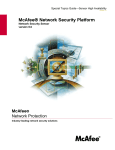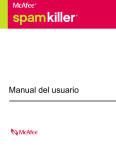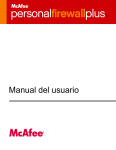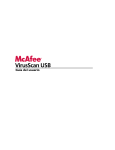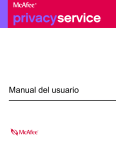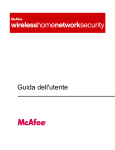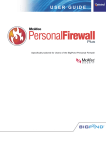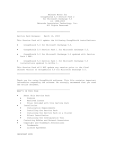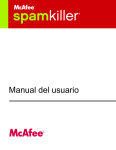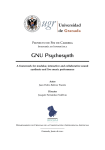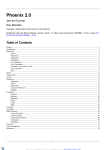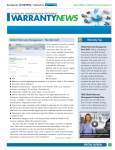Download User Guide
Transcript
User Guide COPYRIGHT Copyright © 2005 McAfee, Inc. All Rights Reserved. No part of this publication may be reproduced, transmitted, transcribed, stored in a retrieval system, or translated into any language in any form or by any means without the written permission of McAfee, Inc., or its suppliers or affiliate companies. TRADEMARK ATTRIBUTIONS ACTIVE FIREWALL, ACTIVE SECURITY, ACTIVESECURITY (AND IN KATAKANA), ACTIVESHIELD, ANTIVIRUS ANYWARE AND DESIGN, CLEAN-UP, DESIGN (STYLIZED E), DESIGN (STYLIZED N), ENTERCEPT, ENTERPRISE SECURECAST, ENTERPRISE SECURECAST (AND IN KATAKANA), EPOLICY ORCHESTRATOR, FIRST AID, FORCEFIELD, GMT, GROUPSHIELD, GROUPSHIELD (AND IN KATAKANA), GUARD DOG, HOMEGUARD, HUNTER, INTRUSHIELD, INTRUSION PREVENTION THROUGH INNOVATION, M AND DESIGN, MCAFEE, MCAFEE (AND IN KATAKANA), MCAFEE AND DESIGN, MCAFEE.COM, MCAFEE VIRUSSCAN, NA NETWORK ASSOCIATES, NET TOOLS, NET TOOLS (AND IN KATAKANA), NETCRYPTO, NETOCTOPUS, NETSCAN, NETSHIELD, NETWORK ASSOCIATES, NETWORK ASSOCIATES COLLISEUM, NETXRAY, NOTESGUARD, NUTS & BOLTS, OIL CHANGE, PC MEDIC, PCNOTARY, PRIMESUPPORT, RINGFENCE, ROUTER PM, SECURECAST, SECURESELECT, SPAMKILLER, STALKER, THREATSCAN, TIS, TMEG, TOTAL VIRUS DEFENSE, TRUSTED MAIL, UNINSTALLER, VIREX, VIRUS FORUM, VIRUSCAN, VIRUSSCAN, VIRUSSCAN (AND IN KATAKANA), WEBSCAN, WEBSHIELD, WEBSHIELD (AND IN KATAKANA), WEBSTALKER, WEBWALL, WHAT'S THE STATE OF YOUR IDS?, WHO'S WATCHING YOUR NETWORK, YOUR E-BUSINESS DEFENDER, YOUR NETWORK. OUR BUSINESS. are registered trademarks or trademarks of McAfee, Inc. and/or its affiliates in the US and/or other countries. Red in connection with security is distinctive of McAfee brand products. All other registered and unregistered trademarks herein are the sole property of their respective owners. LICENSE INFORMATION License Agreement NOTICE TO ALL USERS: CAREFULLY READ THE APPROPRIATE LEGAL AGREEMENT CORRESPONDING TO THE LICENSE YOU PURCHASED, WHICH SETS FORTH THE GENERAL TERMS AND CONDITIONS FOR THE USE OF THE LICENSED SOFTWARE. IF YOU DO NOT KNOW WHICH TYPE OF LICENSE YOU HAVE ACQUIRED, PLEASE CONSULT THE SALES AND OTHER RELATED LICENSE GRANT OR PURCHASE ORDER DOCUMENTS THAT ACCOMPANIES YOUR SOFTWARE PACKAGING OR THAT YOU HAVE RECEIVED SEPARATELY AS PART OF THE PURCHASE (AS A BOOKLET, A FILE ON THE PRODUCT CD, OR A FILE AVAILABLE ON THE WEB SITE FROM WHICH YOU DOWNLOADED THE SOFTWARE PACKAGE). IF YOU DO NOT AGREE TO ALL OF THE TERMS SET FORTH IN THE AGREEMENT, DO NOT INSTALL THE SOFTWARE. IF APPLICABLE, YOU MAY RETURN THE PRODUCT TO MCAFEE OR THE PLACE OF PURCHASE FOR A FULL REFUND. Attributions This product includes or may include: Software developed by the OpenSSL Project for use in the OpenSSL Toolkit (http://www.openssl.org/). Cryptographic software written by Eric A. Young and software written by Tim J. Hudson. Some software programs that are licensed (or sublicensed) to the user under the GNU General Public License (GPL) or other similar Free Software licenses which, among other rights, permit the user to copy, modify and redistribute certain programs, or portions thereof, and have access to the source code. The GPL requires that for any software covered under the GPL which is distributed to someone in an executable binary format, that the source code also be made available to those users. For any such software covered under the GPL, the source code is made available on this CD. If any Free Software licenses require that McAfee provide rights to use, copy or modify a software program that are broader than the rights granted in this agreement, then such rights shall take precedence over the rights and restrictions herein. Software originally written by Henry Spencer, Copyright 1992, 1993, 1994, 1997 Henry Spencer. Software originally written by Robert Nordier, Copyright © 1996-7 Robert Nordier. Software written by Douglas W. Sauder. Software developed by the Apache Software Foundation (http://www.apache.org/). A copy of the license agreement for this software can be found at www.apache.org/licenses/LICENSE-2.0.txt. International Components for Unicode (“ICU”) Copyright © 1995-2002 International Business Machines Corporation and others. Software developed by CrystalClear Software, Inc., Copyright © 2000 CrystalClear Software, Inc. FEAD® Optimizer® technology, Copyright Netopsystems AG, Berlin, Germany. Outside In® Viewer Technology © 1992-2001 Stellent Chicago, Inc. and/or Outside In® HTML Export, © 2001 Stellent Chicago, Inc. Software copyrighted by Software copyrighted by Expat maintainers. Software copyrighted by The Thai Open Source Software Center Ltd. and Clark Cooper, © 1998, 1999, 2000. Regents of the University of California, © 1989. Software copyrighted by Gunnar Ritter. Software copyrighted by Sun Microsystems®, Inc.© 2003. Software copyrighted by Gisle Aas. © 1995-2003. Software copyrighted by Michael A. Chase, © 1999-2000. Software copyrighted by Neil Winton, © 1995-1996. Software copyrighted by RSA Data Security, Inc., © 1990-1992. Software copyrighted by Sean M. Burke, © 1999, 2000. Software copyrighted by Martijn Koster, © 1995. Software copyrighted by Brad Appleton, © 1996-1999. Software copyrighted by Michael G. Schwern, © 2001. Software copyrighted by Graham Barr, © 1998. Software copyrighted by Larry Wall and Clark Cooper, © 1998-2000. Software copyrighted by Frodo Looijaard, © 1997. Software copyrighted by the Python Software Foundation, Copyright © 2001, 2002, 2003. A copy of the license agreement for this software can be found at www.python.org. Software copyrighted by Beman Dawes, © 1994-1999, 2002. Software written by Andrew Lumsdaine, Lie-Quan Lee, Jeremy G. Siek © 1997-2000 University of Notre Dame. Software copyrighted by Simone Bordet & Marco Cravero, © 2002. Software copyrighted by Stephen Purcell, © 2001. Software developed Software copyrighted by International Business Machines Corporation and others, by the Indiana University Extreme! Lab (http://www.extreme.indiana.edu/). © 1995-2003. Software developed by the University of California, Berkeley and its contributors. Software developed by Ralf S. Engelschall <[email protected]> for use in the mod_ssl project (http://www.modssl.org/). Software copyrighted by Kevlin Henney, © 2000-2002. Software Software copyrighted by David Abrahams, © 2001, 2002. See http://www.boost.org/libs/bind/ copyrighted by Peter Dimov and Multi Media Ltd. © 2001, 2002. bind.html for documentation. Software copyrighted by Steve Cleary, Beman Dawes, Howard Hinnant & John Maddock, © 2000. Software copyrighted by Boost.org, © 1999-2002. Software copyrighted by Nicolai M. Josuttis, © 1999. Software copyrighted by Jeremy Siek, © 1999-2001. Software copyrighted Software copyrighted by Chuck Allison and Jeremy Siek, © 2001, 2002. Software copyrighted by Samuel Krempp, © 2001. See by Daryle Walker, © 2001. Software copyrighted by Doug Gregor ([email protected]), © 2001, 2002. Software http://www.boost.org for updates, documentation, and revision history. copyrighted by Cadenza New Zealand Ltd., © 2000. Software copyrighted by Jens Maurer, © 2000, 2001. Software copyrighted by Jaakko Järvi Software copyrighted by Ronald Garcia, © 2002. Software copyrighted by David Abrahams, Jeremy Siek, and Daryle ([email protected]), © 1999, 2000. Walker, © 1999-2001. Software copyrighted by Stephen Cleary ([email protected]), © 2000. Software copyrighted by Housemarque Oy <http:// Software copyrighted by Paul Moore, © 1999. Software copyrighted by Dr. John Maddock, © 1998-2002. Software www.housemarque.com>, © 2001. copyrighted by Greg Colvin and Beman Dawes, © 1998, 1999. Software copyrighted by Peter Dimov, © 2001, 2002. Software copyrighted by Jeremy Siek and John R. Bandela, © 2001. Software copyrighted by Joerg Walter and Mathias Koch, © 2000-2002. Issued September 2005/ McAfee® PrivacyService software Quick Start Card If you are installing your product from a CD or a Web site, print this convenient reference page. Are you installing your product from a CD? Yes 1. Insert your product CD into your CD-ROM drive. If the installation does not start automatically, click Start on your Windows desktop, then click Run. No Are you installing your product from a Web site? Yes 1. Go to the McAfee Web site, and click My Account. 2. In the Run dialog box, type D:\SETUP.EXE (where D is the letter of your CD-ROM drive). 3. Click OK. 2. If prompted, enter your subscribing e-mail address and password, then click Log In to open your Account Info page. 3. Locate your product in the list, and click the download icon. McAfee reserves the right to change Upgrade & Support Plans and policies at any time without notice. McAfee and its product names are registered trademarks of McAfee, Inc. and/or its affiliates in the US and/or other countries. © 2005 McAfee, Inc. All Rights Reserved. User Guide iii Quick Start Card For more information To view the User Guides on the product CD, ensure that you have Acrobat Reader installed; if not, install it now from the McAfee product CD. 1 Insert your product CD into your CD-ROM drive. 2 Open Windows Explorer: Click Start on your Windows desktop, and click Search. 3 Locate the Manuals folder, and double-click the User Guide .PDF you want to open. SpamKiller filter updates for one year after installation when you purchase SpamKiller software Go to http://www.mcafee.com/ for pricing of an additional year of filter updates. McAfee Internet Security Suite updates for one year after installation when you purchase MIS software Go to http://www.mcafee.com/ for pricing of an additional year of content updates. Technical Support Registration benefits For technical support, please visit McAfee recommends that you follow the easy steps within your product to transmit your registration directly to us. Registration ensures that you receive timely and knowledgeable technical assistance, plus the following benefits: http://www.mcafeehelp.com/. FREE electronic support Virus definition (.DAT) file updates for one year after installation when you purchase VirusScan software Go to http://www.mcafee.com/ for pricing of an additional year of virus signatures. 60-day warranty that guarantees replacement of your software CD if it is defective or damaged iv McAfee® PrivacyService software Our support site offers 24-hour access to the easy-to-use Answer Wizard for solutions to the most common support questions. Knowledgeable users can also try our advanced options, which include a Keyword Search and our Help Tree. If a solution cannot be found, you can also access our FREE Chat Now! and E-mail Express! options. Chat and e-mail help you to quickly reach our qualified support engineers through the Internet, at no cost. Otherwise, you can get phone support information at http://www.mcafeehelp.com/. Contents Quick Start Card . . . . . . . . . . . . . . . . . . . . . . . . . . . . . . . . . . . . . . . . iii 1 Getting Started . . . . . . . . . . . . . . . . . . . . . . . . . . . . . . . . . . . . . . . . . 9 Features . . . . . . . . . . . . . . . . . . . . . . . . . . . . . . . . . . . . . . . . . . . . . . . . . . . . . . . . . . . . . . . 9 System requirements . . . . . . . . . . . . . . . . . . . . . . . . . . . . . . . . . . . . . . . . . . . . . . . . . . . . . . 9 The Administrator . . . . . . . . . . . . . . . . . . . . . . . . . . . . . . . . . . . . . . . . . . . . . . . . . . . . . . . 10 Setting up Privacy Service . . . . . . . . . . . . . . . . . . . . . . . . . . . . . . . . . . . . . . . . . . . . . . . . . 10 Setting up a Pre-installed version of Privacy Service . . . . . . . . . . . . . . . . . . . . . . . . 10 Retrieving the Administrator Password . . . . . . . . . . . . . . . . . . . . . . . . . . . . . . . . . . . . . . . 11 Removing Privacy Service with Safe Mode . . . . . . . . . . . . . . . . . . . . . . . . . . . . . . . . 11 The Startup user . . . . . . . . . . . . . . . . . . . . . . . . . . . . . . . . . . . . . . . . . . . . . . . . . . . . . . . . 12 Configuring the Administrator as Startup User . . . . . . . . . . . . . . . . . . . . . . . . . . . . . 12 Using McAfee SecurityCenter . . . . . . . . . . . . . . . . . . . . . . . . . . . . . . . . . . . . . . . . . . . . . . 12 Launching McAfee Privacy Service . . . . . . . . . . . . . . . . . . . . . . . . . . . . . . . . . . . . . . . . . . 13 Launching and signing in to Privacy Service . . . . . . . . . . . . . . . . . . . . . . . . . . . . . . . 13 Disabling Privacy Service . . . . . . . . . . . . . . . . . . . . . . . . . . . . . . . . . . . . . . . . . . . . . 13 Updating McAfee Privacy Service . . . . . . . . . . . . . . . . . . . . . . . . . . . . . . . . . . . . . . . . . . . 14 Removing and Re-installing Privacy Service . . . . . . . . . . . . . . . . . . . . . . . . . . . . . . . . . . . 14 Removing Privacy Service . . . . . . . . . . . . . . . . . . . . . . . . . . . . . . . . . . . . . . . . . . . . 15 Installing Privacy Service . . . . . . . . . . . . . . . . . . . . . . . . . . . . . . . . . . . . . . . . . . . . . 15 2 Adding Users . . . . . . . . . . . . . . . . . . . . . . . . . . . . . . . . . . . . . . . . . 17 Setting the password . . . . . . . . . . . . . . . . . . . . . . . . . . . . . . . . . . . . . . . . . . . . . . . . . . . . . 17 Setting the age group . . . . . . . . . . . . . . . . . . . . . . . . . . . . . . . . . . . . . . . . . . . . . . . . . . . . 17 Setting the cookie blocker . . . . . . . . . . . . . . . . . . . . . . . . . . . . . . . . . . . . . . . . . . . . . . . . . 17 Setting the Internet Time limits . . . . . . . . . . . . . . . . . . . . . . . . . . . . . . . . . . . . . . . . . . . . . 18 Creating Web Site Permissions with Keywords . . . . . . . . . . . . . . . . . . . . . . . . . . . . . . . . . 18 3 Editing Users . . . . . . . . . . . . . . . . . . . . . . . . . . . . . . . . . . . . . . . . . 21 Changing passwords . . . . . . . . . . . . . . . . . . . . . . . . . . . . . . . . . . . . . . . . . . . . . . . . . . . . . 21 Changing a user’s information . . . . . . . . . . . . . . . . . . . . . . . . . . . . . . . . . . . . . . . . . . . . . . 21 Changing cookie blocker setting . . . . . . . . . . . . . . . . . . . . . . . . . . . . . . . . . . . . . . . . . . . . 21 User Guide v Contents Editing the Accept and Reject Cookie List . . . . . . . . . . . . . . . . . . . . . . . . . . . . . . . . . 22 Changing the age group . . . . . . . . . . . . . . . . . . . . . . . . . . . . . . . . . . . . . . . . . . . . . . . . . . 22 Changing Internet time Limits . . . . . . . . . . . . . . . . . . . . . . . . . . . . . . . . . . . . . . . . . . . . . . 22 Changing the Startup user . . . . . . . . . . . . . . . . . . . . . . . . . . . . . . . . . . . . . . . . . . . . . . . . . 23 Removing users . . . . . . . . . . . . . . . . . . . . . . . . . . . . . . . . . . . . . . . . . . . . . . . . . . . . . . . . . 23 4 Options . . . . . . . . . . . . . . . . . . . . . . . . . . . . . . . . . . . . . . . . . . . . . . 25 Blocking Web sites . . . . . . . . . . . . . . . . . . . . . . . . . . . . . . . . . . . . . . . . . . . . . . . . . . . . . . 25 Allowing Web sites . . . . . . . . . . . . . . . . . . . . . . . . . . . . . . . . . . . . . . . . . . . . . . . . . . . . . . 25 Blocking information . . . . . . . . . . . . . . . . . . . . . . . . . . . . . . . . . . . . . . . . . . . . . . . . . . . . . 25 Adding information . . . . . . . . . . . . . . . . . . . . . . . . . . . . . . . . . . . . . . . . . . . . . . . . . . 26 Editing information . . . . . . . . . . . . . . . . . . . . . . . . . . . . . . . . . . . . . . . . . . . . . . . . . . 26 Removing personal information . . . . . . . . . . . . . . . . . . . . . . . . . . . . . . . . . . . . . . . . . 26 Blocking Web bugs . . . . . . . . . . . . . . . . . . . . . . . . . . . . . . . . . . . . . . . . . . . . . . . . . . 26 Blocking advertisements . . . . . . . . . . . . . . . . . . . . . . . . . . . . . . . . . . . . . . . . . . . . . . . . . . 26 Allowing cookies from specific Web sites . . . . . . . . . . . . . . . . . . . . . . . . . . . . . . . . . . . . . 27 5 Event Log . . . . . . . . . . . . . . . . . . . . . . . . . . . . . . . . . . . . . . . . . . . . 29 Date and time . . . . . . . . . . . . . . . . . . . . . . . . . . . . . . . . . . . . . . . . . . . . . . . . . . . . . . . . . . 29 User . . . . . . . . . . . . . . . . . . . . . . . . . . . . . . . . . . . . . . . . . . . . . . . . . . . . . . . . . . . . . . . . . . 29 Summary . . . . . . . . . . . . . . . . . . . . . . . . . . . . . . . . . . . . . . . . . . . . . . . . . . . . . . . . . . . . . . 29 Event Details . . . . . . . . . . . . . . . . . . . . . . . . . . . . . . . . . . . . . . . . . . . . . . . . . . . . . . . . . . . 29 Saving the Current Log . . . . . . . . . . . . . . . . . . . . . . . . . . . . . . . . . . . . . . . . . . . . . . . . . . . 29 Viewing Saved Logs . . . . . . . . . . . . . . . . . . . . . . . . . . . . . . . . . . . . . . . . . . . . . . . . . . . . . 30 6 Utilities . . . . . . . . . . . . . . . . . . . . . . . . . . . . . . . . . . . . . . . . . . . . . . 31 Erasing files permanently using McAfee Shredder . . . . . . . . . . . . . . . . . . . . . . . . . . . . . . 31 Why Windows leaves file remnants . . . . . . . . . . . . . . . . . . . . . . . . . . . . . . . . . . . . . . 31 What McAfee Shredder erases . . . . . . . . . . . . . . . . . . . . . . . . . . . . . . . . . . . . . . . . . 31 Permanently erasing files in Windows Explorer . . . . . . . . . . . . . . . . . . . . . . . . . . . . . 32 Emptying the Windows Recycle Bin . . . . . . . . . . . . . . . . . . . . . . . . . . . . . . . . . . . . . 32 Customizing Shredder settings . . . . . . . . . . . . . . . . . . . . . . . . . . . . . . . . . . . . . . . . . 32 Backing up the Privacy Service database . . . . . . . . . . . . . . . . . . . . . . . . . . . . . . . . . . . . . 32 Restoring the Backup Database . . . . . . . . . . . . . . . . . . . . . . . . . . . . . . . . . . . . . . . . . . . . 33 7 User Options . . . . . . . . . . . . . . . . . . . . . . . . . . . . . . . . . . . . . . . . . . 35 Changing your password . . . . . . . . . . . . . . . . . . . . . . . . . . . . . . . . . . . . . . . . . . . . . . . . . . 35 vi McAfee® PrivacyService software Contents Changing your user name . . . . . . . . . . . . . . . . . . . . . . . . . . . . . . . . . . . . . . . . . . . . . . . . . 35 Clearing your cache . . . . . . . . . . . . . . . . . . . . . . . . . . . . . . . . . . . . . . . . . . . . . . . . . . . . . . 36 Accepting cookies . . . . . . . . . . . . . . . . . . . . . . . . . . . . . . . . . . . . . . . . . . . . . . . . . . . . . . . 36 If you need to remove a web site from this list: . . . . . . . . . . . . . . . . . . . . . . . . . . . . . 36 Rejecting cookies . . . . . . . . . . . . . . . . . . . . . . . . . . . . . . . . . . . . . . . . . . . . . . . . . . . . . . . 37 If you need to remove a web site from this list: . . . . . . . . . . . . . . . . . . . . . . . . . . . . . 37 Index . . . . . . . . . . . . . . . . . . . . . . . . . . . . . . . . . . . . . . . . . . . . . . . . 39 User Guide vii Contents viii McAfee® PrivacyService software 1 Getting Started Thank you for purchasing McAfee® Privacy Service™. McAfee Privacy Service software offers advanced protection for you, your family, your personal data, and your computer. Features This release of McAfee Privacy Service includes the following features: Internet time usage rules - Specify days and times when users can access the Internet. Custom keyword filtering - Create keyword rules that permit or block users from accessing Web sites. Privacy Service backup and restore - Save and restore Privacy Service settings at any time. Web bug blocker—Block Web bugs (objects obtained at potentially harmful web sites) so that they are not loaded within browsed web pages. Pop-up blocker—Prevent pop-up windows from displaying as you browse the Internet. Shredder—McAfee Shredder protects your privacy by quickly and safely erasing unwanted files. System requirements Microsoft® Windows 98SE, Me, 2000, or XP Personal computer with Pentium-compatible processor Windows 98, 2000: 133 MHz or higher Windows Me: 150 MHz or higher Windows XP (Home and Pro): 300 MHz or higher RAM Windows 98, Me, 2000: 64 MB Windows XP (Home and Pro): 128 MB User Guide 9 Getting Started 40 MB hard disk space Microsoft® Internet Explorer 5.5 or later NOTE To upgrade to the latest version of Internet Explorer, visit the Microsoft Web site at http://www.microsoft.com/. The Administrator The Administrator specifies which users can access the Internet, when they can use it, and what they can do on the Internet. NOTE The Administrator is considered an adult and as such can access all web sites but is prompted to allow or prevent the transmission of added personal identifiable information (PII). Setting up Privacy Service The Setup Assistant allows you to create the Administrator, manage global settings, enter personal information, and add users. Remember your Administrator password and security answer so that you can logon to Privacy Service. If you cannot logon, you cannot use Privacy Service and the Internet. Keep your password secret so only you can change Privacy Service settings. Some Web sites require that cookies are enabled to work properly. Privacy Service always accepts cookies from McAfee.com. NOTE If your PC includes a pre-installed copy of Privacy Service, some steps described in this documentation may not appear. For more information, see Setting up a Pre-installed version of Privacy Service on page 10 and your PC manufacturer's documentation. Setting up a Pre-installed version of Privacy Service If Privacy Service is pre-installed on Windows XP, you must logon to Windows with a Windows Administrator account to set up the product. To configure a pre-installed version of Privacy Service: 1 If you have not done so already, launch the Setup Assistant using one of the following methods: Right-click the McAfee icon in the Windows system tray, point to Privacy Service, and then select Setup Privacy Service. 10 McAfee® PrivacyService software Retrieving the Administrator Password From the Windows Start menu, point to McAfee, and then select McAfee Privacy Service. Double-click the McAfee Privacy Service desktop icon. Launch the McAfee SecurityCenter, click the privacy service tab, and then Setup Privacy Service to launch the Setup Assistant. 2 Proceed to and complete each step that is provided. NOTE To cancel configuration, click Cancel. Retrieving the Administrator Password If you forget the Administrator password, you can access the password using the security information you entered when you created the Administrator profile. To retrieve the Administrator password: 1 Right-click the McAfee icon in the Windows system tray, point to McAfee Privacy Service, then select Sign In. 2 Select Administrator from the User Name pull-down menu. 3 Click Forgot your password? 4 Enter the answer to the security question that appears, and then click Get Password. A message appears containing your password. If you forget the answer to the security question, you must remove McAfee Privacy Service from Safe Mode (Windows 2000 and Windows XP only). Removing Privacy Service with Safe Mode To remove Privacy Service with Safe Mode: 1 Click Start and point to Shut Down. The Shut Down Windows dialog box appears. 2 Select Shut down from the menu and then click OK. 3 Wait until the It is now safe to turn off the computer message appears, and then turn the computer off. 4 Turn the computer back on. 5 Begin immediately pressing the F8 key, every other second, until the Windows Startup menu appears. 6 Select Safe Mode and press Enter. 7 When Windows starts, a message appears explaining Safe Mode. Click OK. User Guide 11 Getting Started 8 Proceed to Add or Remove Programs, located in the Windows Control Panel. When you are done, reboot the PC. 9 Re-install McAfee Privacy Service and specify the Administrator password. Make a note of the password you specify. NOTE You can remove Privacy Service in Safe Mode in Windows 2000 or Windows XP only. The Startup user The Startup user is automatically signed in to Privacy Service when the computer is started. For example, if a user is on the computer or Internet more than the others, you can make that user, including the Administrator, the Startup user. When the Startup user uses the computer, the user is not required to sign in to Privacy Service. If you have young children, you can also set the Startup user to the youngest. This way, when an older user uses the computer, they can log off from the young user's account and then log in again using their own user name and password. This protects younger users from seeing inappropriate Web sites. Configuring the Administrator as Startup User To configure the Administrator as Startup user: 1 From the Please Sign In dialog, select your user name from the User name pull-down menu. 2 Enter your password in the Password field. 3 Select Make this user the Startup User, and then sign in. Using McAfee SecurityCenter McAfee SecurityCenter is your one-stop security shop, accessible from its icon in your Windows system tray or from your Windows desktop. With it, you can access Privacy Service and perform other useful tasks: Get free security analysis for your computer. Launch, manage, and configure all your McAfee subscriptions from one icon. See continuously updated virus alerts and the latest product information. Get quick links to frequently asked questions and account details at the McAfee web site. 12 McAfee® PrivacyService software Launching McAfee Privacy Service For more information about SecurityCenter features, click Help in the SecurityCenter dialog box. When SecurityCenter is running and all of the McAfee features installed on your computer are enabled, a red M icon appears in the Windows system tray. This area is usually in the lower-right corner of the Windows desktop and contains the clock. If one or more of the McAfee applications installed on your computer are disabled, the McAfee icon changes to black . To launch McAfee SecurityCenter: Right-click the McAfee icon SecurityCenter. in the Windows system tray, then select Open Launching McAfee Privacy Service After you install McAfee Privacy Service, the McAfee icon appears in the Windows system tray, which is located near the system clock. From the McAfee icon, you can access McAfee Privacy Service, McAfee SecurityCenter, and other McAfee products installed on your computer. NOTE If your product is pre-installed, you must first set it up. For more information, see Setting up a Pre-installed version of Privacy Service on page 10. Launching and signing in to Privacy Service 1 Right-click the McAfee icon in the Windows system tray, point to McAfee Privacy Service, and then select Sign In. 2 Select your user name from the User name pull-down menu. 3 Enter your Password in the Password field. 4 Click Sign In. Disabling Privacy Service You must be logged in to Privacy Service as the Administrator to disable it. To disable Privacy Service: Right-click the McAfee icon select Sign Out. , point to McAfee Privacy Service, and then User Guide 13 Getting Started NOTE If Sign In is in the place of Sign Out, then you are already signed out. Updating McAfee Privacy Service McAfee SecurityCenter regularly checks for updates to Privacy Service while your computer is running and connected to the Internet. If an update is available, McAfee SecurityCenter prompts you to update Privacy Service. To manually check for updates: Click the Updates icon located in the top pane. Removing and Re-installing Privacy Service You must be logged in to Privacy Service as the Administrator to un-install the product. If this McAfee product is pre-installed on your computer, see your PC manufacturer's documentation for information about removing and re-installing Privacy Service. NOTE Removing Privacy Service erases all Privacy Service data. 14 McAfee® PrivacyService software Removing and Re-installing Privacy Service Removing Privacy Service To remove Privacy Service: 1 Save all of your work and close any open applications. 2 Open the Control Panel: Windows 98, Windows Me, and Windows 2000 users-Select Start, point to Settings, and then click Control Panel. Windows XP users-On your Windows taskbar, select Start, and then click Control Panel. 3 Open the Add/Remove Programs dialog box: Windows 98, Me, and 2000 users-Double-click Add/Remove Programs. Windows XP users-Click Add or Remove Programs. 4 Select McAfee Privacy Service from the list of programs, and then click Change/Remove. 5 When asked to confirm the operation, click Yes. 6 When you are prompted to restart your system, click Close. Your computer restarts to complete the un-installation process. Installing Privacy Service To install Privacy Service: 1 Go to the McAfee Web site and navigate to the Privacy Service page. 2 Click the Download link on the Privacy Service page. 3 Click Yes on any messages that appear asking if you want to download files from the McAfee web site. 4 Click Start Installation on the Privacy Service Installation window. 5 When the download is complete, click Restart to restart your computer. Or, click Close if you need to save any work or quit any programs, then restart your computer as you normally would. You must restart your computer in order for Privacy Service to work properly. After the computer restarts, you need to create the Administrator again. If this McAfee product is pre-installed on your computer, see your PC manufacturer's documentation for information about re-installing Privacy Service. User Guide 15 Getting Started 16 McAfee® PrivacyService software 2 Adding Users To add users, you must sign in to Privacy Service as the Administrator. 1 Right-click the McAfee icon in the Windows system tray. 2 Point to McAfee Privacy Service, then select Manage Users. The Select A User dialog box appears. 3 Click Add and enter the new user's name in the User name field. Setting the password 1 Enter a password in the Password field. The password can be up to 50 characters and can contain uppercase and lowercase letters and numbers. 2 Enter the password again in the Confirm Password field. 3 Select Make this user the Startup user if you want this user to be the Startup user. 4 Click Next. When assigning passwords, consider the age of the person. For example, if you assign a password to a young child, make the password simple. If you assign a password to an older teenager or an adult, make the password more complex. Setting the age group Select the appropriate age-based setting, and then click Next. Setting the cookie blocker Select the appropriate option, and then click Next. Reject all cookies—Renders cookies unreadable to the web sites that sent them. Some web sites require you to enable cookies to work properly. Prompt user to accept cookies—Enables you to decide if you want to accept or reject cookies on a case-by-case basis. Privacy Service notifies you when a web site you are about to view wants to send a cookie to your computer. After you make your choice, you are not asked about that cookie again. User Guide 17 Adding Users Accept all cookies—Allows web sites to read the cookies they send to your computer. NOTE Some web sites, to work properly, require that cookies are enabled. Privacy Service accepts cookies from McAfee at all times. Setting the Internet Time limits To grant unrestricted Internet use: 1 Select Can use Internet anytime. 2 Click Create. The new user appears in the Select A User list. To grant limited Internet use: 1 Select Restrict Internet usage, and then click Edit. 2 On the Internet Time Limits page, drag across the time grid to select the time and day the user can access the Internet. You can specify time limits in thirty-minute intervals. Green portions of the grid are the periods a user can access the Internet. Red portions show when a user cannot access the Internet. If a user tries to use the Internet when they are not allowed to, Privacy Service displays a message telling the user that they are not allowed to use the Internet at this time. To modify the periods a user can access the Internet, drag across the green portions of the grid. 3 Click Done. 4 Click Create. The new user appears in the Select A User page. If a user tries to use the Internet when they are not allowed to, Privacy Service displays a message telling the user that they are not allowed to use the Internet at this time. To prohibit Internet use: Select Restrict Internet Usage, and then click Create. When the user uses the computer, they are prompted to sign in to Privacy Service. They can use the computer, but not the Internet. Creating Web Site Permissions with Keywords Privacy Service maintains a default list of keywords and corresponding rules, which determines whether a user of a certain age level is permitted to browse a Web site where a keyword exists. 18 McAfee® PrivacyService software Adding Users The Administrator can add his or her own allowable keywords to the Privacy Service database and associate these with certain age levels. Keyword rules, added by the Administrator, will override the rule associated with any matching keyword in the default Privacy Service database. An Administrator can either lookup existing keywords or specify new keywords to associate with certain age levels. To create keyword Web site permissions: 1 Right-click the McAfee icon in the Windows system tray, point to Privacy Service, then select Options. 2 Click the Keywords tab. 3 In the Word Lookup field, type a word for an age level. 4 In the Permissions pane, select the age level to associate with the word. Age levels include the following: Young Child Child Younger Teenager Older Teenager Adult The keyword and its selected age group appear in the Word List. Age levels that appear above the associated level are blocked from accessing Web sites which contain the word. The age level, to which the word was assigned, and those that appear below it, are allowed to access Web sites where the word exists. To modify existing Web site permissions: 1 Right-click the McAfee icon in the Windows system tray, point to Privacy Service, then select Options. 2 Click the Keywords tab. 3 In the Word Lookup field, type a word that you want to modify, and click Lookup. The word appears if it exists in the Privacy Service database. User Guide 19 Adding Users 20 McAfee® PrivacyService software 3 Editing Users To edit users, you must sign in to Privacy Service as the Administrator. Changing passwords 1 Select the user whose information you are changing and click Edit. 2 Select Password, and enter the user's new password in the New password field. The password can be up to 50 characters and can contain uppercase and lowercase letters and numbers. 3 Enter the same password in the Confirm password field, and then click Apply. 4 Click OK in the confirmation dialog box. NOTE An Administrator can change a user’s password without knowing the user’s current password. Changing a user’s information 1 Select the user whose information you are changing and click Edit. 2 Select User Info. 3 Enter the new user name in the New user name field. 4 Click Apply, and then click OK in the confirmation dialog box. 5 To restrict a user to viewing the web sites in the Allowed Web Sites list, select Restrict this user to Web sites in the "Allowed Web Sites" list. Changing cookie blocker setting 1 Select the user whose information you are changing and click Edit. 2 Select Cookies, and then select the appropriate option. Reject all cookies—Renders cookies unreadable to the web sites that sent them. Some web sites require you to enable cookies to work properly. User Guide 21 Editing Users Prompt user to accept cookies—Enables you to decide if you want to accept or reject cookies on a case-by-case basis. Privacy Service notifies you when a web site you are about to view wants to send a cookie to your computer. After you make your choice, you are not asked about that cookie again. Accept all cookies—Allows web sites to read the cookies they send to your computer. 3 Click Apply, and then click OK in the confirmation dialog box. Editing the Accept and Reject Cookie List 1 Select Prompt user to accept cookies and click Edit to specify which web sites are allowed to read cookies. 2 Specify the list you are modifying by selecting Web sites that can set cookies or Web sites that cannot set cookies. 3 In the http:// field, enter the address of the web site that you are accepting or rejecting cookies from. 4 Click Add. The web site appears in the Web site list. 5 Click Done when you are finished making changes. NOTE Some web sites, to work properly, require that cookies are enabled. Privacy Service accepts cookies from McAfee at all times. Changing the age group 1 Select the user whose information you are changing and click Edit. 2 Select Age Group. 3 Select a new Age Group for the user, and then click Apply. 4 Click OK in the confirmation dialog box. Changing Internet time Limits 1 Select the user whose information you are changing and click Edit. 2 Select Time Limits and do the following: To permit unlimited Internet access: 1 22 Select Can use Internet anytime and click Apply. McAfee® PrivacyService software Editing Users 2 Click OK in the confirmation dialog box. To restrict Internet access: 1 Select Restrict Internet usage and click Edit. 2 On the Internet Time Limits page, select a green or red square, and then drag across the grid to change existing times and days a user can access the Internet. You can specify time limits in thirty-minute intervals. Green portions of the grid are the periods a user can access the Internet. Red portions show when a user cannot access the Internet. If a user tries to use the Internet when they are not allowed to, Privacy Service displays a message telling the user that they are not allowed to use the Internet at this time. 3 Click Apply. 4 On the Time Limits page, click OK. 5 In the McAfee Privacy Service McAfee Privacy Service confirmation dialog, click OK. Changing the Startup user The Administrator can change the Startup user at any time. If a Startup user already exists, you do not have to deselect them as a Startup user. 1 Select the user that you want to designate as the Startup user, and then click Edit. 2 Select User Info. 3 Select Make this user the Startup user. 4 Click Apply and then click OK in the confirmation dialog box. NOTE You can assign a Startup user from the Please Sign In dialog also. For more information, see The Startup user on page 12 Removing users 1 Select the user you want to remove, and then click Remove. 2 Click Yes in the confirmation dialog box. 3 Close the Privacy Service window when you are finished making changes. User Guide 23 Editing Users 24 McAfee® PrivacyService software 4 Options To configure Privacy Service options, you must sign in to Privacy Service as the Administrator. Blocking Web sites 1 Click Options, and then select Block List. 2 In the http:// field, enter the URL of the web site that you want to block, and then click Add. The web site appears in the Blocked Web Sites list. NOTE Users (including Administrators) that belong to the Adult group level can access all web sites, even if the web sites are in the Blocked Web Sites list. To test blocked web sites, Administrators must log in as non-adult users. Allowing Web sites The Administrator can allow all users to view specific web sites. This overrides Privacy Service's default settings and web sites added to the Blocked list. 1 Click Options, and then select Allow List. 2 In the http:// field, enter the URL of the web site that you want to allow, and then click Add. The web site appears in the Allowed Web Sites list. Blocking information The Administrator can prevent other users from sending specific personal information over the Internet (the Administrator can still send this information). When Privacy Service detects personal identifiable information (PII) in something about to be sent out, the following occurs: If you are an Administrator, you are prompted, and can decide whether to send the information or not. If the logged in user is not the Administrator, the blocked information is replaced with MFEMFEMFE. For example, if you send the e-mail Lance Armstrong wins tour, and Armstrong is set as personal information that is to be blocked, then the e-mail that is actually sent is Lance MFEMFEMFE wins tour. User Guide 25 Options Adding information 1 Click Options, and then select Block Info. 2 Click Add. The Select Type pull-down menu appears. 3 Select the type of information that you want to block. 4 Enter the information in the appropriate fields, and then click OK. The information you entered appears in the list. Editing information 1 Click Options, and then select Block Info. 2 Select the information that you want to edit, and click Edit. 3 Make the appropriate changes, and then click OK. If the information does not need to be changed, click Cancel. Removing personal information 1 Click Options, and then select Block Info. 2 Select the information that you want to remove, and click Remove. 3 Click Yes in the confirmation dialog box. Blocking Web bugs Web bugs are small graphic files that can send messages to third parties, including tracking your Internet browsing habits or transmitting personal information to an external database. Third parties can then use this information to create user profiles. To prevent web bugs from being loaded within browsed web pages, select Block Web Bugs on this computer. Blocking advertisements Advertisements are typically graphics served from a third party domain into a web page or pop-up window. Privacy Service does not block ads that are served from the same domain as the host web page. Pop-ups are secondary browser windows presenting unwanted advertisements, which automatically display when as you visit a web site. Privacy Service only blocks those pop-ups that are automatically loaded when a web page loads. Pop-ups initiated by clicking a link are not blocked by Privacy Service. To display a blocked pop-up, hold down the CTRL key and refresh the web page. 26 McAfee® PrivacyService software Options Configure Privacy Service to block advertisements and pop-ups when you are using the Internet. 1 Click Options, and then select Block Ads. 2 Select the appropriate option. Block ads on this computer—Blocks advertisements while you are using the Internet. Block Pop-Ups on this computer—Blocks pop-ups while you are using the Internet. 3 Click Apply, and then click OK in the confirmation dialog box. To disable pop-up blocking, right-click the web page, point to McAfee Pop-Up Blocker, and deselect Enable Pop-up Blocker. Allowing cookies from specific Web sites If you block cookies or require to be prompted before they are accepted, and find that certain web sites do not function properly, then configure Privacy Service to allow the site to read its cookies. 1 Click Options, and then select Cookies. 2 In the http:// field, enter the address of the web site that needs to read its cookies, and then click Add. The address appears in the Accept Cookie Web Sites list. User Guide 27 Options 28 McAfee® PrivacyService software Event Log 5 To view the event log, you must sign in to Privacy Service as the Administrator. Then, select Event Log and click any log entry to view its details. To save or view a saved log, select the Saved Logs tab. Date and time By default, the Event Log displays information in chronological order, with the most recent events at the top. If the Event Log entries are not in chronological order, click the Date and Time heading. The date is displayed in a month/day/year format, and the time is displayed in the A.M./P.M. format. User The user is the person who was logged in and using the Internet at the time Privacy Service recorded the event. Summary Summaries display a short, concise description of what Privacy Service is doing to protect users and what users are doing on the Internet. Event Details The Event Details field displays entry details. Saving the Current Log The Current Log page displays information about recent administrative and user actions. You can save this information to view at a future date. To save a current event log 1 Sign In to Privacy Service as the Administrator. 2 Select Event Log. User Guide 29 Event Log 3 On the Current Log page, click Save Log. 4 In the File name field, type the name for the log file. 5 Click Save. Viewing Saved Logs The Current Log page displays information about recent administrative and user actions. You can save this information to view at a future date. To view a saved log 30 1 Sign In to Privacy Service as the Administrator. 2 Select Event Log. 3 On Current Log page, click Open Log. 4 In the Select a saved log to view dialog, select the backup database file, and click Open. McAfee® PrivacyService software 6 Utilities To access the utilities, you must sign in to Privacy Service as the Administrator, and then click Utilities. To remove files, folders, or the entire contents of disks, click McAfee Shredder. To save your Privacy Service database settings, click Backup. To restore your settings, click Restore. Erasing files permanently using McAfee Shredder McAfee Shredder unwanted files. protects your privacy by quickly and safely erasing Deleted files can be recovered from your computer even after you empty your Recycle Bin. When you delete a file, Windows merely marks that space on your disk drive as no longer being in use, but the file is still there. Why Windows leaves file remnants To permanently delete a file, you must repeatedly overwrite the existing file with new data. If Microsoft Windows securely deleted files, every file operation would be very slow. Shredding a document does not always prevent that document from being recovered because some programs make temporary hidden copies of open documents. If you only shred documents that you see in Explorer, you could still have temporary copies of those documents. We recommend that you periodically shred the free space on your disk drive to insure that these temporary copies are permanently deleted. NOTE With computer forensics tools, tax records, job resumes, or other documents that you had deleted, could be obtained. What McAfee Shredder erases With McAfee Shredder, you can securely and permanently erase: One or more files or folders An entire disk The trails that your web surfing leaves behind User Guide 31 Utilities Permanently erasing files in Windows Explorer To shred a file via Windows Explorer: 1 Open Windows Explorer, then select the file or files that you want to shred. 2 Right-click your selection, point to Send To, and then select McAfee Shredder. Emptying the Windows Recycle Bin If files are in your Recycle Bin, McAfee Shredder offers a more secure method of emptying your Recycle Bin. To shred the contents of the Recycle Bin: 1 On your Windows desktop, right-click the Recycle Bin. 2 Select Shred Recycle Bin, then follow the on-screen instructions. Customizing Shredder settings You can: Specify the number of shredding passes. Show a warning message when you shred files. Check your hard disk for errors before shredding. Add McAfee Shredder to your Send To menu Place a Shredder icon on your Windows desktop. To customize Shredder settings, open McAfee Shredder, click Properties, and then follow the on-screen instructions. Backing up the Privacy Service database You can restore the Privacy Service database two ways. If your database becomes corrupted or is deleted, Privacy Service prompts you to restore the Privacy Service database. Alternatively, you can restore your database settings while running Privacy Service. 32 1 Click Utilities, and then select Backup. 2 Click Browse to select a location for the database file, and then click OK. 3 Enter a password in the Password field. 4 Enter the password again in the Confirm password field, and then click Backup. 5 Click OK in the confirmation dialog box. McAfee® PrivacyService software Utilities 6 Close the Privacy Service window when you are finished. NOTE Keep this password secret, and do not forget it. You cannot restore Privacy Service settings without this password. Restoring the Backup Database 1 Privacy Service provides two ways to restore your original settings: Load your backup database file after Privacy Service prompts you to restore your settings because the database is corrupt or deleted. Load your backup database file while running Privacy Service. To restore your Privacy Service Settings when prompted: 1 Click Browse to locate the file. 2 Type your password in the Password field. 3 Click Restore. If you did not back up the Privacy Service database, or you forgot your Backup password, or restoring the database does not work, please remove and re-install Privacy Service. To restore your Privacy Settings while running Privacy Service: 1 Click the Utilities tab. 2 Click Restore. 3 Click Browse, and type the path and name for the backup file. 4 Click Open. 5 Type your password in the Password field. 6 Click Restore, and then click OK in the McAfee Privacy Service confirmation dialog. User Guide 33 Utilities 34 McAfee® PrivacyService software 7 User Options These instructions do not apply to the Administrator. You can change your password and user name. We recommend that you change your password after the Administrator gives it to you. We also recommend that you change your password once a month, or if you think someone knows your password. This helps prevent others from using the Internet with your user name. Changing your password 1 Right-click the McAfee icon, point to McAfee Privacy Service, and then select Options. 2 Click Password and enter your old password in the Old password field. 3 Enter your new password in the New password field. 4 Type your new password again in the Confirm password field, and then click Apply. 5 Click OK in the confirmation dialog box. You now have a new password. Changing your user name 1 Right-click the McAfee icon, point to McAfee Privacy Service, and then select Options. 2 Click User Info. 3 Type your new user name in the New user name field and then click Apply. 4 Click OK in the confirmation dialog box. You now have a new user name. User Guide 35 User Options Clearing your cache We recommend that you clear your cache so that a child does not access web pages you recently visited. To clear your cache, do the following. 1 Open Internet Explorer. 2 From the Tools menu, click Internet Options. The Internet Options dialog box appears. 3 In the Temporary Internet Files section, click Delete Files. The Delete Files dialog box appears. 4 Select Delete all offline content, and then click OK. 5 Click OK to close the Internet Options dialog box. Accepting cookies This option is available only if the Administrator allows you to accept or reject cookies as they are intercepted. If you access web sites that require cookies, you can allow those sites permission to read cookies. 1 Right-click the McAfee icon, point to McAfee Privacy Service, and then select Options. 2 Click Accepted Cookies. 3 Enter the URL of the web site in the http:// field, and then click Add. The web site appears in the Web Site list. If you need to remove a web site from this list: 36 1 Select the web site's URL in the Web site list. 2 Click Remove, and then click Yes in the confirmation dialog box. McAfee® PrivacyService software User Options Rejecting cookies This option is available only if the Administrator allows you to accept or reject cookies as they are intercepted. If you access web sites that do not require cookies, you can reject the cookies without being prompted. 1 Right-click the McAfee icon, point to McAfee Privacy Service, and then select Options. 2 Click Rejected Cookies. 3 Enter the URL of the web site in the http:// field, and then click Add. The web site appears in the Web site list. If you need to remove a web site from this list: 1 Select the web site's URL in the Web Site list. 2 Click Remove, and then click Yes in the confirmation dialog box. User Guide 37 User Options 38 McAfee® PrivacyService software Index blocking web sites, web bugs, 26 A adding users, 17 content blocking, 17 cookie blocking, 17 Internet time limits, 18 administrator, 10 retrieving password, 11 E editing users, 21 age group, 22 cookie blocking, 21 Internet time limits, 22 password, 21 removing users, 23 startup user, 23 user information, 21 event log, 29 F features, 9 25 Q Quick Start Card, iii S setup assistant, 10 Shredder, 31 Startup user, 12, 17 system requirements, 9 U uninstalling McAfee Privacy Service, from Safe Mode, 11 user options, 35 accepting cookies, 36 changing your password, 35 changing your user name, 35 clearing your cache, 36 rejecting cookies, 37 utilities, 31 15 M McAfee Privacy Service, disabling, 13 opening, 13 signing in, 13 updating, 12, 14 McAfee Security Center, 13 12 O options, 25 allowing cookies, 27 allowing web sites, 25 backup, 32 blocking advertisements, 26 blocking information, 25 User Guide 39










































